PLANT STRAWBERRY PLANT(S)
/6 Comments/in Fruit/by Lee ReichHumble Appearing Beginnings
The UPS man’s face is a familiar one this time of year, as he brings me boxes and bags of plants from all around the country. I can’t count how many times I’ve met his brisk walk up the driveway to retrieve a box of strawberry plants. A strawberry bed languishes after a few years, typically five years, and when that happens, I just choose a new site and order new plants.
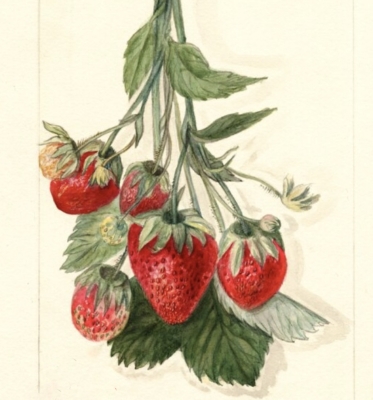
Epsey strawberry, painted in 1911
I begin again with new plants, because although strawberries are perennial plants, old plantings eventually pick up diseases from wild strawberries and related plants. By planting a new bed the year before the old one is due to expire, there’s no break in enjoying fresh strawberries every June.
Opening the box of strawberry plants just arrived provides a sorry sight to the eyes: twenty-five plants, leafless or nearly leafless, bound with a rubber band into a package small enough to hold in my fist. But I take heart; the plants are dormant and, given warmth and soil, will come to life. Immediately as I say good-bye to the UPS guy I open the plastic bag to make sure there’s some moisture within. If not, I add some and reseal the bag. In either case I put the bag in the refrigerator until I’m ready to plant.
Planting Location and Design
Let’s hold off planting a minute and see what type of site I choose for my strawberry beds. The plants thrive best with full sun (at least 6 hours per day with Ol’ Sol beaming directly on the plants) and in a soil that is both well-drained and rich in organic matter. Anything less than the above and fruit flavor suffers and plants are more prone to disease.
Strawberry plants spread by runners, which are stems that creep along the ground forming new plants at intervals along their length. 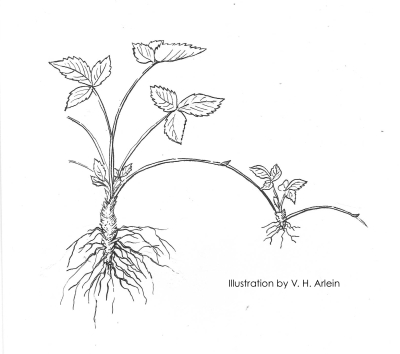 Eventually, plants in a strawberry bed should be 6 to 12 inches apart. The “matted row” system of strawberry planting makes full use of these runners. Plants are set far apart (4 feet between rows and 2 feet between plants) and the spaces between the plants fill in with runner plants which fruit the following season.
Eventually, plants in a strawberry bed should be 6 to 12 inches apart. The “matted row” system of strawberry planting makes full use of these runners. Plants are set far apart (4 feet between rows and 2 feet between plants) and the spaces between the plants fill in with runner plants which fruit the following season. 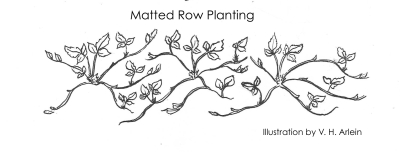 The matted row is allowed to fill in to a width of 2 feet, and all plants attempting to spread beyond that width are kept in bounds with a rototiller or by hand. With age, that 2 foot ribbon rapidly becomes overcrowded unless old plants are weeded out.
The matted row is allowed to fill in to a width of 2 feet, and all plants attempting to spread beyond that width are kept in bounds with a rototiller or by hand. With age, that 2 foot ribbon rapidly becomes overcrowded unless old plants are weeded out.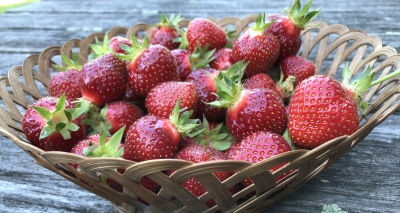
I prefer the opposite extreme in strawberry planting systems, the “hill” system, whereby plants are set in a double row with 12 inches between the rows and between plants in the row. (If there’s more than one double row, the next double row is 3 feet away.) 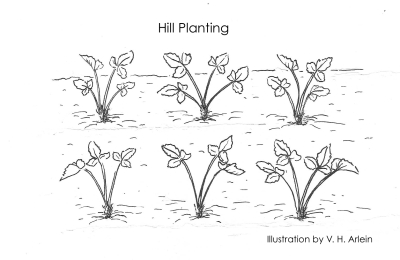 The hill system demands the somewhat tedious job of pinching off all runners through the summer, but the planting stays neater and yields the most berries the first bearing season.
The hill system demands the somewhat tedious job of pinching off all runners through the summer, but the planting stays neater and yields the most berries the first bearing season.
The “spaced plant” system splits the difference between the hill system and the matted row system. Plants are set moderately far apart, and only 4 or 5 daughter plants are allowed to take root, carefully spaced around each mother plant.
And Into the Ground They Go
Actual planting of strawberries in the ground takes little time if the soil is in good condition — weed-free, rich in humus, and not too dry and not too moist. Gently squeeze a handful; it should crumble.
I prepare the plants by retrieving them from the refrigerator, undoing the bundle, and trimming the roots back to three or four inches. Then I drop the plants into a shallow pan of water to keep them moist while I plant.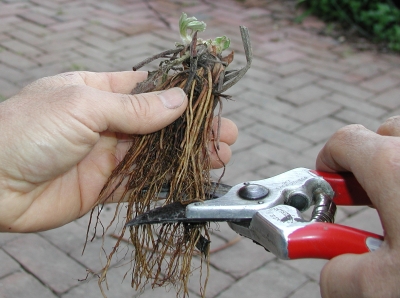
To plant, I thrust a trowel straight down into the soil, then pull the handle towards me enough to open up a slit for a plant. 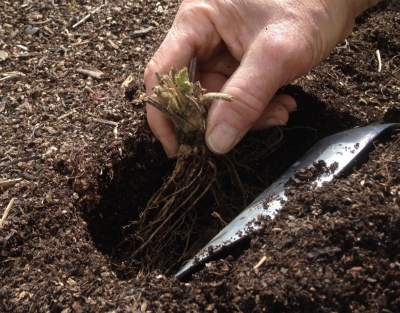 With the roots fanned out by my other hand, the trimmed plant’s roots fit easily into the waiting slit. Planting is completed as I remove the trowel and firm soil against the roots with the heel of my hand.
With the roots fanned out by my other hand, the trimmed plant’s roots fit easily into the waiting slit. Planting is completed as I remove the trowel and firm soil against the roots with the heel of my hand.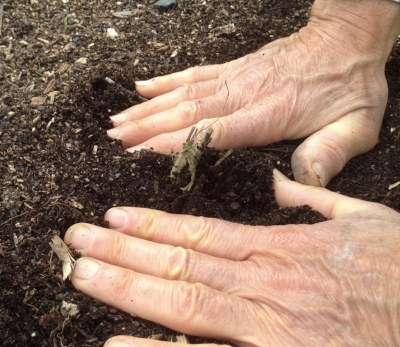
Planting depth is important. Set too shallow and the plants dry out, set too deeply and they suffocate. The ground line should go right through the middle of the crown, which is actually a stem that’s been telescoped down so that each leaf grows off it right next to the next leaf along the stem, rather than a few inches apart, as in most stems.
A number of years back I was helping my friend Helene plant her first strawberry bed. Sorry Helene, gotta write about it. My job was to open up the holes; your job was to plant. After a dozen holes, I glanced back over my shoulder to check your progress. You had listened carefully: each plant was set with the ground line through the middle of the crown, against which the soil was firmed, even lovingly smoothed. And, as I had instructed, you had neatly fanned out each plant’s roots. How did I know? Because the plants were upside down, with their roots splayed upward in the air!
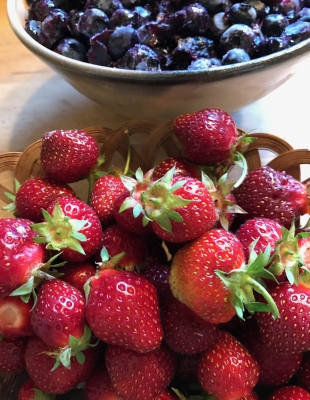
First blueberries on heels of last strawberries
TEASING APART HYDRANGEAS
/3 Comments/in Flowers, Pruning/by Lee ReichGood Answer
When someone asks me how they should prune their hydrangea, I give them the answer that most people don’t like to any question “It depends.” What else can I say? It DOES depend. One or more of a few species of hydrangeas commonly make their home in our yards, and you have to approach each, pruning shears or loppers in hand, differently.
Let me tease apart the answer by, first, taking a look a what hydrangea or hydrangeas we may be growing, and then how they grow and flower, which, in turn, speaks to when and where to start snipping away.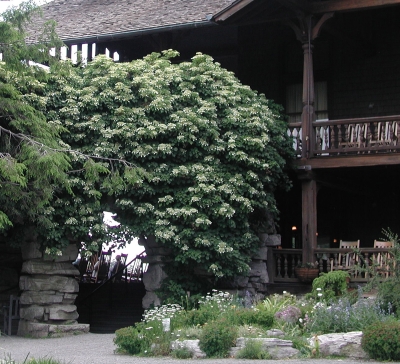
Mopheads and Lacecaps, and Oakleafs
If the hydrangea plant in question is a shrub bearing blue or pink flowers, it’s a so-called Bigleaf Hydrangea (Hydrangea macrophylla). Mopheads types, also called hortensias, bear softball to volleyball size clusters of florets. Lacecap types bear flat-topped cluster of small, hardly conspicuous florets surrounded by rims of showy, larger, 4-petalled florets.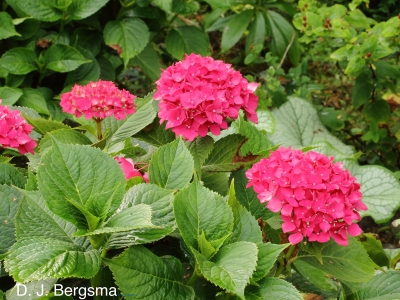
Whether mophead or lacecap, Bigleaf Hydrangeas flowers open from buds they set up the previous year. Those buds are big and fat, in contrast to the skinny buds that grow out to become shoots.
Prune Bigleaf Hydrangea stems as far as the fat buds while the plants are leafless (now, for instance). Right after bloom, cut the stems further back to near ground level.
Problem is that while the plants can stand up to bitter cold, the flower buds can’t, expiring at temperatures below about minus 5° Fahrenheit. Some varieties set their flower buds lower on the stem than do others. Their buds might more reliably stand up to winter cold if plants are mulched in late fall with some loose organic material like straw or arborists’ wood chips.
Pushing Bigleaf Hydrangea growing further north are some recently developed varieties that bloom on new, growing shoots. These new varieties — the first one of which was named Endless Summer — will bloom anywhere. Blossoms on new shoots unfurl later in the season than those on older wood, too late in some gardens (like mine, some years). Cutting back older shoots after they flower fuels a better show from the young, growing shoots.
Oakleaf Hydrangea (H. quercifolia) is another hydrangea that is very cold hardy, except for it flower buds. Flowers sit on the ends of stems in elongated clusters, like cotton candy. Oakleaf Hydrangea can be pruned just like Bigleaf Hydrangea, except that it grows as a large shrub so need not be cut back so much.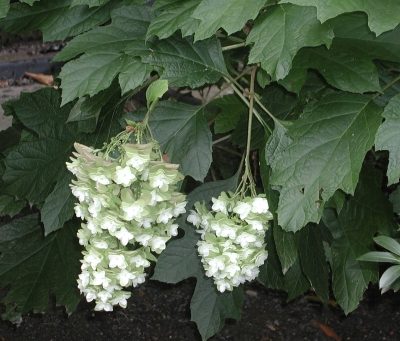
Lack of a flowery show from Oakleaf Hydrangea is no loss because a billowing mound or mounds of the oak-like leaves are attractive in their own right through summer, and also in fall, when the leaves turn rich, burgundy red. Even where winter cold would test the reliability of flowering, Oak Leaf Hydrangea is often planted solely for its form and its leaves.
A Beautiful Climber
Years ago, I planted a Climbing Hydrangea (H. animal petiolaris) at the base of the north wall of my home. It took a couple of years or more to get in gear, but now completely clothes that wall. Though leafless through winter, the peeling, light mahogany bark stands prettily against the brick red backdrop. 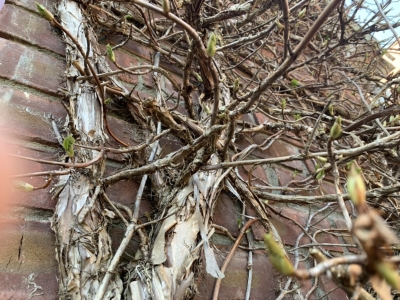 Soon the stems will be draped in glossy, green leaves and, a little after that, white flowers that stand proud of the wall on short stalks and glow against their dark backdrop like a starry night.
Soon the stems will be draped in glossy, green leaves and, a little after that, white flowers that stand proud of the wall on short stalks and glow against their dark backdrop like a starry night.
This time of year my pruning consists of shortening shorten flower stalks that reach too far out from the wall and vigorous stems that keep trying to sneak around the wall to clothe the rest of the house. Twice in summer I prune stems again to restrain the plant to only the north wall.
Perhaps I’ll plant another Climbing Hydrangea at the base of my 90 foot tall Norway spruce that with age is thinning out. The hydrangea tolerates sun or shade, and can climb a tree without causing harm.
And, Easiest of All
Rounding out this romp through pruning hydrangeas are two of the easiest to prune plants of the species. The first, Smooth Hydrangea (H. arborescens), grows long shoots from ground level, each capped in early summer with half-foot-wide clusters of of white or pastel flowers. To prune, just lop all stems right to the ground in late winter or early spring.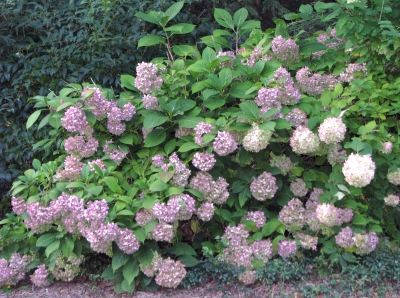
And finally, we come to PeeGee, sometimes called Panicle, Hydrangea (H. paniculata grandiflora), growing like a small tree or large shrub. This one blossoms in late summer on new growth, so if it is going to be pruned, that needs to be done before growth begins. 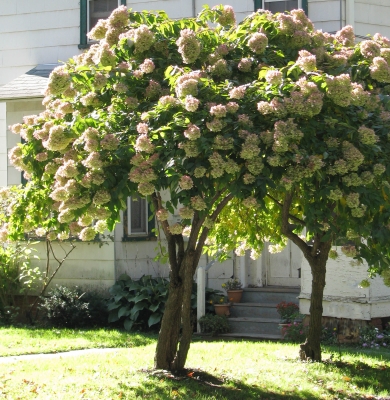 With that said, Panicle Hydrangea develops a permanent trunk or trunks, making it difficult to reach high into its dense head for pruning. No matter, because the plant flowers quite well with little or no pruning.
With that said, Panicle Hydrangea develops a permanent trunk or trunks, making it difficult to reach high into its dense head for pruning. No matter, because the plant flowers quite well with little or no pruning.
Hydrangea is only one group of closely related plants where species differ in how they are pruned. Roses would be another example; climbing roses are pruned very differently from rambling roses, which are pruned very differently from . . . you get the picture. Clematis also. For more details about the individual pruning needs of these as well as lots of other trees, shrubs, vines, flowers, fruits, and houseplants, and special pruning techniques like pollarding, mowing and scything (yes, that’s pruning!), and espalier, take a look at my book The Pruning Book. It’s available through the usual sources or, signed, directly from me here.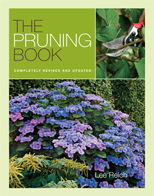
GOURMET FERTILIZER
/14 Comments/in Gardening/by Lee ReichVegetarian Plants
The other day in the hardware store I overheard someone ask the clerk for some rose food. My eyebrows went up as I thought to m’self, “Are they kidding, thinking that roses need their own special food? Next, I’ll hear about plants that prefer vegetarian or kosher food, perhaps fish emulsion on Fridays?”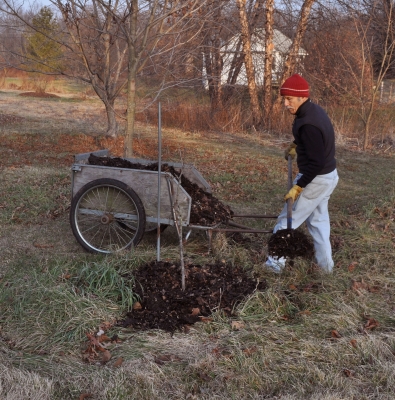
All this food science when it comes to plants may boost fertilizer sales, but it hardly bothers plants either way. Plants take up the bulk of their nutrients as ions (charged atoms or groups of atoms) that are dissolved in water in the soil. Rock particles, as well as humus and organic fertilizers, decompose to release nutrient ions slowly into the soil solution. Chemical fertilizers are already in ionic form, so when you sprinkle a handful on the soil, they dissolve as soon as they contact water.
A Well-Rounded, Wholesome Diet
What’s so special about rose food for roses? Nothing. All plants need healthy doses of nitrogen, phosphorus, and potassium, and lesser amounts of other nutrient elements. But unless a soil is an infertile sand where neither crop rotation nor some weed growth is allowed to balance soil nutrients, specific foods don’t usually have to be tailored for specific plants.
My garden grows pretty well, and I feed all my plants the same diet: An annually replenished mulch of wood chips, leaves, or compost, and, if extra nitrogen is needed, an annual sprinkling of soybean meal. Theoretically and in practice, an inch depth of compost alone provides sufficient nourishment for the plants. 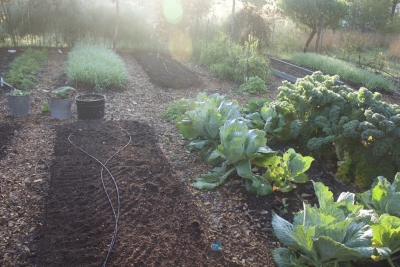 That inch depth of compost is the only thing my vegetable beds get each year, and it nourishes closely planted cabbages, tomatoes, lettuces, and other plants from the first breath of spring until cold weather barrels in to shut down production.
That inch depth of compost is the only thing my vegetable beds get each year, and it nourishes closely planted cabbages, tomatoes, lettuces, and other plants from the first breath of spring until cold weather barrels in to shut down production.
Garden plants that are pressed into sustained production (nonstop flowering of those rose bushes, for example) or vegetables best plumped up with extra-succulence, like some leafy vegetables, might need an extra push with additional nitrogen. Or not.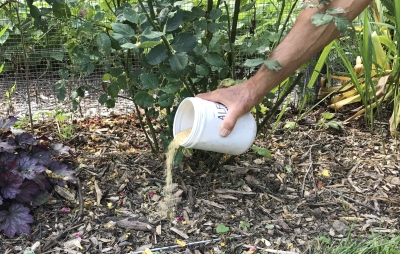
Soybean meal, available in garden centers as well as anywhere selling animal feeds, is insurance in the form of a high nitrogen, organic fertilizer. Cottonseed meal, hoof and horn meal, alfalfa meal, or blood meal would serve as well. Soil microorganisms decompose the proteins in any of these fertilizers in a series of steps to produce amino acids, then ammonium ions, then nitrate ions. The latter two ions are the forms of nitrogen most utilized by plants.
I grew Brussels sprouts unsuccessfully for many years, with sprouts hardly bigger than marbles lining up along the spindly stalks. So last year, I sprinkled some soybean meal (2 pounds per hundred square feet) on the ground before laying down the compost. Success! The plants grew into sturdy, five-foot-high stalks along which were lined up almost golfball-sized sprouts.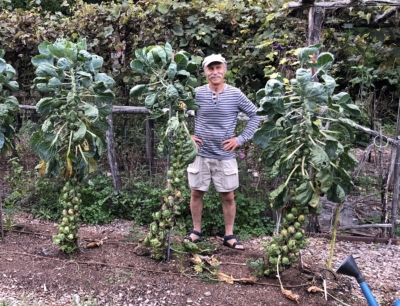
Flowers and mature trees and bushes get nothing more than arborists’ wood chips, leaves, hay, straw, or wood shavings here. Even these low nitrogen mulches eventually release nitrogen as their lower layers break down in the soil.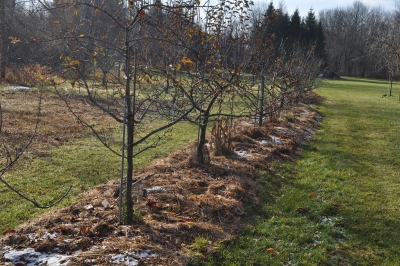
But Still . . .
You might point out that, still, there are some plants that need a specialty plant food: “acid plant food” for azaleas and rhododendrons, for example. You’ve got a point; these plants do have special needs. But my universal pabulum of mulch and soybean meal also suffices for them.
The special requirement of these plants is an acid soil. If a soil is not naturally acidic, the soil doesn’t need an “acid plant food,” it needs to be made acidic. The way to make a soil acidic is with sulfur, a naturally mined mineral. The amount needed depends on the existing soil acidity (determined with a quick soil test), the desired soil acidity (a pH of about 5 for acid-loving plants), and whether the soil is sandy or clayey. A sandy soil needs about 3⁄4# per 100 sq. ft. for each pH unit change; clay soils need about two-and-a-half times that amount. The sulfur to use is “pelletized” because it’s less dusty to work with. And, obviously, any compost for these plants should have had no added limestone.
What about the special nitrogen requirement of these plants? Commercial “acid plant food” supplies acid-loving plants with their preferred form of nitrogen, which is ammonium ion. Let’s see what happens to my soybean meal in an acid soil. A few paragraphs earlier, I wrote that though an orchestrated series of steps, various soil microorganisms gobble up proteins in soybean meal or other organic fertilizers, breaking them down to amino acids, ammonium ions, and then nitrate ions. In acidic soils, microorganisms that do that last job are absent. Breakdown stops at ammonium ion — just what those plants like best.
Plants don’t need haut cuisine, just plain, wholesome food. (More details about this in Weedless Gardening and The Ever Curious Gardener.)

